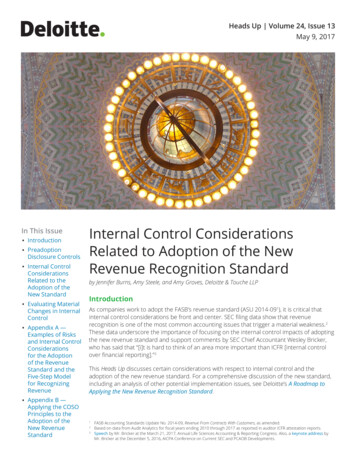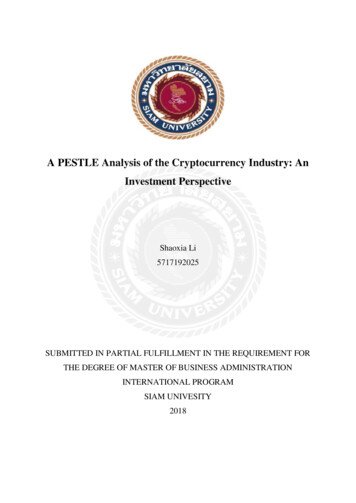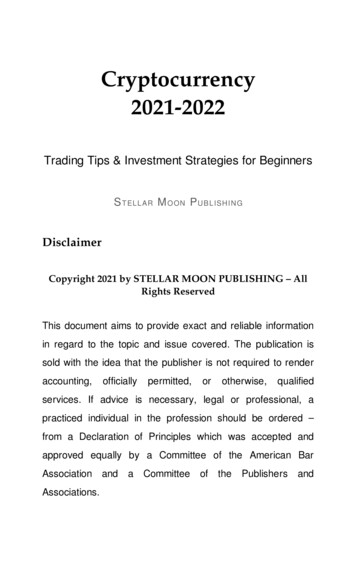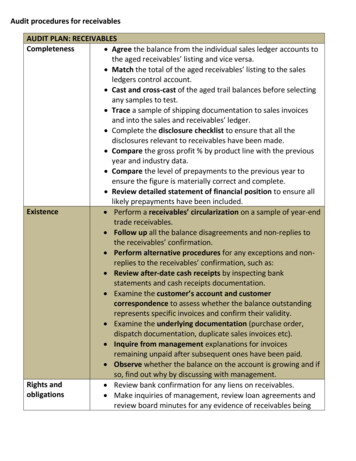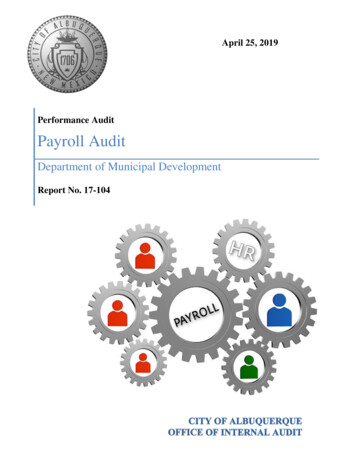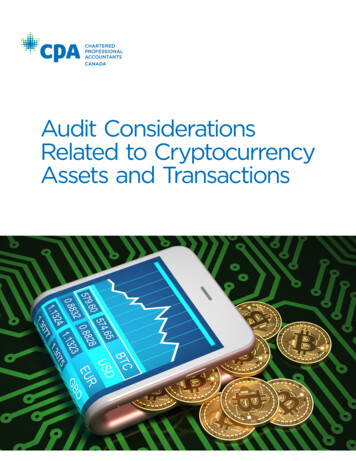
Transcription
Audit ConsiderationsRelated to CryptocurrencyAssets and Transactions
Audit ConsiderationsRelated to CryptocurrencyAssets and Transactions
DISCLAIMERThis paper was prepared by the Chartered Professional Accountants of Canada (CPA Canada)as non-authoritative guidance.CPA Canada and the authors do not accept any responsibility or liability that might occur directlyor indirectly as a consequence of the use, application or reliance on this material. 2018 Chartered Professional Accountants of CanadaAll rights reserved. This publication is protected by copyright. Written permission is required to reproduce, storein a retrieval system or transmit in any form or by any means (electronic, mechanical, photocopying, recording,or otherwise).For information regarding permission, please contact permissions@cpacanada.ca.
iiiTable of ContentsExecutive Summary1Introduction3Scope5Client Acceptance and Continuance Considerations6Integrity of the Client Including Its Business Purposein Entering into Cryptocurrency Transactions7Client’s Level of Understanding of CryptocurrencyRisks and Relevant Aspects of Internal Control8Competence and Capabilities of Those Involvedin Performing the Engagement8The Entity’s Information Systemfor Cryptocurrency Transactions9Example of a Cryptocurrency Purchase10Cryptocurrency Wallets11Examples of Matters to Consider When Identifyingand Assessing Risks of Material Misstatement inCryptocurrency Transactions and Balances14Conclusion25Appendix A — Where to Find More Information26Appendix B — Glossary of Terms27
1Executive SummaryAn entity’s financial statements may include material cryptocurrency items.This paper is intended to be useful to auditors who have little or no experiencewith cryptocurrencies and may not fully appreciate the challenges presentedwhen auditing these items. Highlights of matters described in this paper areset out below. lient Acceptance and Continuance ConsiderationsCMatters to consider include, for example:—— integrity of the client, including the business purpose for whichthe entity is entering into cryptocurrency transactions (e.g., thattransactions do not involve money laundering or other illegal acts)—— management’s level of understanding of cryptocurrency risks andinternal control over cryptocurrency transactions and balances—— whether the audit engagement partner is satisfied that those involvedin the engagement (including members of the engagement teamand any auditor’s external experts) collectively have the appropriatecompetence and capabilities in information technology (IT) andcryptocurrencies to perform the engagement in accordance withprofessional standards. Obtaining an Understanding of the Entity’s Information System forCryptocurrency TransactionsMatters such as cryptography and blockchains are complex. Referencesources are provided to enable readers to obtain information on thesetopics. A simplified example of a process to purchase cryptocurrency isprovided. There is also a brief description of various types of cryptocurrency wallets. These contain the entity’s private and public cryptographickeys used in selling cryptocurrency and are used to monitor the entity’scryptocurrency balance.
2Audit Considerations Related to Cryptocurrency Assets and Transactions Examples of Matters to Consider in Identifying and Assessing Risks ofMaterial Misstatement in Cryptocurrency Transactions and BalancesNine examples are provided of conditions or events that may result ina material misstatement. The material briefly describes matters relatedto the condition or event, notes the related assertions, and providesexamples of internal control considerations. The nine conditions orevents are as follows:1. The entity chooses to use a cryptocurrency exchange that does nothave effective controls over the transactions it enters into on behalfof the entity or over the balances of cryptocurrency maintained in theentity’s accounts.2. The entity has a cryptocurrency wallet that has not been accounted for.3. The entity loses a private key and therefore can no longer access therelated cryptocurrency.4. An unauthorized party obtains access to the entity’s private key andsteals the entity’s cryptocurrency.5. The entity misrepresents ownership of a private key and therefore ofthe related cryptocurrency.6. The entity sends cryptocurrency to an incorrect address and thecryptocurrency cannot be recovered.7. The entity enters into and records a cryptocurrency transaction witha related party that cannot be identified because of the anonymity ofparties to blockchain transactions.8. There are significant delays in processing cryptocurrency transactionsat the end of a period.9. Events or conditions make it difficult to determine the value at whicha cryptocurrency should be recorded for financial reporting purposes.
3IntroductionHoldings of cryptocurrencies allow individuals and businesses to transactdirectly with each other without an intermediary such as a bank or otherfinancial institution. These cryptocurrency transactions rely on blockchaintechnology. For an introduction to blockchain technology and the related auditimplications, refer to the CPA Canada publication, Blockchain Technology andIts Potential Impact on the Audit & Assurance Profession.The rapid rise and volatility of cryptocurrencies have led to increased globalinterest and scrutiny by organizations, investors, regulators, governments andothers. During 2017, the market capitalization of cryptocurrencies increased byUS 547 billion or 3,038%.1 The most popular and widely used cryptocurrencyis Bitcoin; however, there are over 1,600 cryptocurrencies in circulation.2 Eachof these cryptocurrencies has its own unique features and characteristics whichmakes understanding, accounting and auditing them particularly challenging.It is becoming common for financial statements to show cryptocurrency balances and to reflect the results of cryptocurrency transactions. However, manyauditors may have little or no experience with cryptocurrencies and thereforemay not fully appreciate the challenges that auditing these items may present.This non-authoritative publication is intended to provide auditors with examplesof matters to consider when: deciding whether to accept or continue an audit engagement whenan entity has engaged in material cryptocurrency transactions identifying and assessing risks of material misstatement in financialstatements related to cryptocurrency transactions and //coinmarketcap.com as at June 19, 2018.
4Audit Considerations Related to Cryptocurrency Assets and TransactionsWe encourage auditors to continue to monitor developments in this space andwe invite readers to contact us with any feedback or insights that could helpus develop future publications on this topic.Taryn Abate, CPA, CA, CPA (IL)Director, Audit & AssuranceResearch, Guidance and SupportCPA Canada277 Wellington Street WestToronto ON M5V 3H2Email: tabate@cpacanada.ca
5ScopeThis publication focuses only on engagements to audit financial statementsthat show material cryptocurrency balances. It does not discuss other typesof engagements, such as review of financial statements containing materialcryptocurrency items. However, matters discussed in this publication may beadapted as necessary by practitioners performing other types of engagements.This publication does not discuss procedures that might be performed inresponse to assessed risks (i.e., tests of controls and substantive procedures).Some auditing firms are exploring the nature, timing and extent of suchprocedures. Practice will likely evolve as more experience is gained.This publication also does not discuss matters such as auditing: liabilities resulting from agreements to pay amounts owing usinga cryptocurrency financial statements of a cryptocurrency exchange financial statements of entities that:—— validate cryptocurrency transactions on a blockchain(i.e., cryptocurrency miners)—— issue Initial Coin Offerings (ICOs) or Initial Token Offerings (ITOs) investments in ICOs and ITOs controls related to the infrastructure supporting a blockchain, such asthe hardware and software used in operating a node aspects of income tax expense and liability that may be affected by alack of clarity in how tax laws and regulations apply to cryptocurrencytransactions and balances controls implemented by a service organization (perhaps a cryptocurrencyexchange) and complementary controls designed and implemented bythe entity. For example, any entity’s cryptocurrency wallet(s) may behosted by a cryptocurrency exchange or other type of entity providingthis service, resulting in that organization being significantly involved incryptocurrency transactions and custody of an entity’s cryptocurrency.
6Client Acceptance andContinuance ConsiderationsCanadian Standard on Quality Control 1 (CSQC 1)requires a firm to establish policies and procedures for the acceptance and continuance ofclient relationships and specific engagements.Auditingcryptocurrencytransactions canbe complex:These policies and procedures are designed toHave you consideredprovide the firm with reasonable assurance thatall relevant mattersit will only undertake or continue relationshipsbefore acceptingand engagements where the firm:or continuing an1. Is competent to perform the engagementengagement?and has the capabilities, including time andresources, to do so;2. Can comply with relevant ethical requirements; and3. Has considered the integrity of the client, and does not have informationthat would lead it to conclude that the client lacks integrity.An entity’s use of cryptocurrency is likely to be relevant to the auditor indeciding whether to accept or continue an engagement to audit an entity’sfinancial statements. An auditor may encounter circumstances where, forexample, the entity has: entered into material cryptocurrency transactions for the first time significantly changed the nature or increased the extent of its cryptocurrency activities from previous years. For example, an investment entitythat previously focused primarily on traditional investment vehicles maydecide that a significant part of its investment portfolio will now includecryptocurrencies.
Client Acceptance and Continuance ConsiderationsExamples of matters to consider regarding client acceptance or continuanceare set out below.Integrity of the Client Including Its Business Purposein Entering into Cryptocurrency TransactionsAn example of a matter for the auditor to consider regarding client integrityis whether there are indications the client might be involved in money laundering or other criminal activities. There are legitimate business reasonsto use cryptocurrencies. However, cryptocurrencies have also been usedto launder the proceeds of criminal activities and to finance terrorism andother illegal acts. These types of activity are enabled by the anonymity ofparticipants in blockchain transactions. Also, exchanges where cryptocurrencies are traded for fiat currencies remain largely unregulated (e.g., some arenot subject to regulations that apply to banks such as know-your-customer(KYC) and anti-money laundering (AML) rules and requirements to keep arecord of unusual transactions).The auditor’s engagement acceptance or continuance procedures wouldtherefore likely include inquiries and related procedures to obtain an understanding of the entity’s business purpose in entering into cryptocurrencytransactions for the first time or significantly changing the nature or extentof its cryptocurrency activities. A key consideration is whether the entity’s significant cryptocurrency transactions are in the normal course of its business.If the auditor identifies significant cryptocurrency transactions that are outsidethe normal course of business, the auditor is required to: evaluate whether it gives rise to significant risks3 inquire of management about the nature of these transactions andwhether related parties could be involved,4 and whether the business rationale (or the lack thereof) suggests thatthey may have been entered into to engage in fraudulent financialreporting or to conceal misappropriation of assets.5The auditor is also required to remain alert to the possibility of instancesof non-compliance or suspected non-compliance with laws and regulations,including money laundering or other illegal activities.63Paragraph 27 of CAS 315, Identifying and Assessing the Risks of Material Misstatement through Understanding the Entity and Its Environment.4Paragraph 16 of CAS 550, Related Parties.5Paragraph 33(c) of CAS 240, The Auditor’s Responsibilities Relating to Fraud in an Audit of FinancialStatements.6Paragraph 16 of CAS 250, Consideration of Laws and Regulations in an Audit of Financial Statements.7
8Audit Considerations Related to Cryptocurrency Assets and TransactionsClient’s Level of Understanding of CryptocurrencyRisks and Relevant Aspects of Internal ControlTo establish whether the preconditions for an audit engagement are present,the auditor obtains the agreement of management that it acknowledges andunderstands its responsibility for certain matters, including: the preparation of the financial statements in accordance with theapplicable financial reporting framework, including, where relevant,their fair presentation internal controls necessary to enable the preparation of financial statements free from material misstatement whether due to fraud or error.7Ideally, the client would have an understanding of matters related tocryptocurrency, including its financial reporting implications. The client alsowould have designed and implemented controls related to its cryptocurrencytransactions and balances. However, an auditor may encounter circumstanceswhere the prospective client has not even implemented a process to track itscryptocurrency transactions. In these circumstances, it may be very difficultor not practicable to au
4 Audit Considerations Related to Cryptocurrency Assets and Transactions We encourage auditors to continue to monitor developments in this space and we invite readers to contact us with any feedback or insights that could help us develop future publications on this topic. Taryn Abate, CPA, CA, CPA (IL) Director, Audit & Assurance
